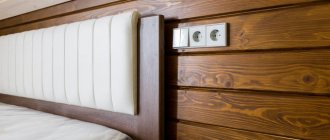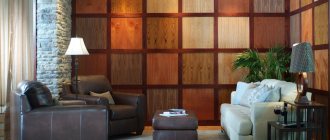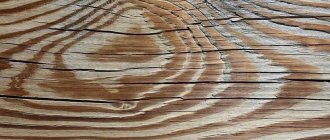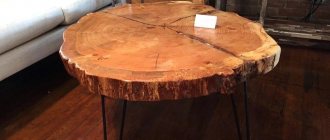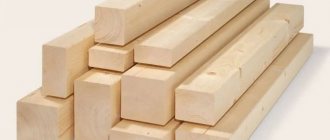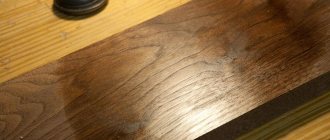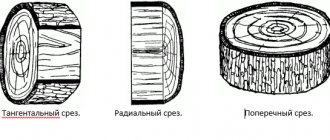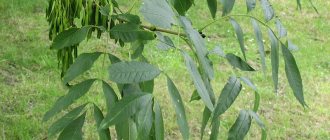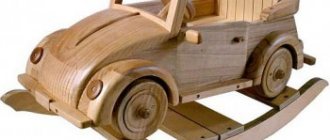Natural wood trim is still popular. Especially in wooden houses and baths, country houses, on loggias. And in popular interiors in country style, Provence, Russian rustic. Only they use not boards, but linings and eurolinings. These are profiled thin boards, completely ready for cladding walls and ceilings.
On the side edges the lining has protrusions for connecting the boards together (tongue and groove). Eurolining, as a rule, is distinguished by a complex decorative profile and the presence of longitudinal grooves. They compensate for warping when wet and dry.
What should you protect wood from?
Any natural building materials are exposed to the external environment - they are able to expand when the temperature rises, absorb moisture, and also fade under the rays of the sun. The tree is especially vulnerable in this regard. It is a living organism, and after being cut from the root it loses moisture. The drying process is accompanied by cracking and deformation, and at the same time, with an increased level of air humidity or even contact with water, the wood begins to actively absorb it, and as a result, swell.
The accumulation of moisture in the wood will certainly lead to mold and mildew spores settling in it, which begin to quickly develop and destroy the structure, penetrating deeper and capturing the surface. Signs of such damage will be visual differences - uneven wood texture, gray/white/bluish and black deposits, stains that spoil the appearance of the wood structure. Gradually the tree becomes ordinary dust.
Please note that rot caused by fungi is dangerous not only because it has a destructive effect on wood, but is also very harmful to human health. Fungal spores that are in the air penetrate deep into the lungs and begin to cause various diseases.
For many structures, this situation will be very dangerous, even if high aesthetic requirements are not imposed on them. For example, if you don’t think in advance about what exactly to cover the porch of a barn with or to process wooden fence posts, then after a short time everything will rot and the fence will not be able to bear the load that was previously calculated.
The second dangerous factor is fire, which wood cannot withstand without special treatment. In addition, wood-boring insects, which gnaw many passages in it, will irreversibly destroy the structure of the material and deprive it of its former strength.
Moreover, after a certain time, the surface of untreated wood parts begins to darken and an ugly gray tint is obtained, and the material becomes covered with deep cracks. All this will not have the best effect on the appearance, and therefore it is worth deciding how to cover the wood outdoors so that both the strength and beauty of the material are preserved for a long time.
Functions of wood preservatives
The presence of wood in the interior always gives the room coziness and plays a significant role in increasing comfort, since it has a beautiful natural structure.
Wood species used in construction have the following qualities:
- High strength due to fibrous structure.
- High thermal insulation characteristics.
- Possibility of repairing or replacing damaged material.
- Ease of processing.
- Low cost. The price of untreated wood is significantly lower than other types of flooring.
The main advantage of wood is its naturalness, which at the same time has a number of disadvantages such as:
- The softness of the material, which wears out during active use.
- Exposure to moisture.
- Changes in size and disruption of structure under the influence of the sun and temperature changes.
- High flammability.
- Favorable environment for the growth of mold and fungal bacteria.
Important. Before creating a wooden floor for a gazebo, the wood used must be subjected to additional processing with various means that increase the physical characteristics of the material and protect it from harmful effects.
How to effectively protect a tree
How to treat the lining inside the house?
This question is often asked by owners who have used wood in the interior decoration of their home. Today, processing lining inside the house is not a problem. You just need to choose the right protective coating that will suit a particular room.
Some are more suitable for rooms with high humidity, others perfectly protect boards from ultraviolet rays, and some generally increase the strength of wood and prevent the risk of premature abrasion.
But also an important factor when processing is that the protection should look good on the boards . It should not distort the natural structure of the tree. On the contrary, its task is to emphasize the naturalness of the material used and blend harmoniously with the rest of the interior.
Most often, the following substances are used to protect wood:
- Antiseptic
- Wax
- Varnish
- Bio oil
- Primer
What does pre-treatment include?
Preparing a wooden base before painting includes the following steps:
- Surface cleaning. Dust, dirt and remnants of old decorative material will affect the final result of the work: the paint will lie unevenly and quickly begin to peel off.
- Application of protection. The choice of protective agent depends on the factors that will affect the wooden base.
- Padding. Applying various primers before painting increases the adhesion of the finish coat. If painting is done without prior priming, its service life will be significantly reduced.
Painting works and tools for them
Some have not encountered this type of work, so it will be useful for them to learn all the technical aspects of finishing with lining and painting it.
So, what tools will you need to carry out painting work:
- paint roller;
- paint brushes, the bristles of which should be hard. There should be several of them;
- construction tape;
- sandpaper (grit number 240);
- napkins;
- container for roller and brushes.
Painting tools
We advise you to rinse your brushes in a soapy solution before starting work, so that during the process they do not leave their fluff on the surface to be painted and treated.
Treatment with protective compounds
The quality of your work will depend on attentiveness and accuracy, as well as on the correctness and consistency of compliance with all rules and recommendations. Full instructions are presented in the video:
Types of wood paints and their characteristics
When choosing paint for wooden facades, it is important to consider the type of wood. Among the variety of materials, it is necessary to highlight the main points for yourself, namely the characteristics that it should have. Therefore, it is customary to divide it into groups and subgroups depending on their purposes, features and composition.
When choosing paint for wooden facades, it is important to consider the type of wood.
By wear-resistant we mean the resistance of the coating to mechanical loads. The abrasion coefficient of the composition should not exceed four percent over a ten-year period. Such products are characterized by increased vapor permeability and ease of application.
Compositions of the wear-resistant group are based on natural or synthetic oils. Depending on the presence or absence of auxiliary additives, physical characteristics may change, therefore, when choosing, you should pay attention to the full range of indicators.
By wear-resistant we mean the resistance of the coating to mechanical loads.
This class is characterized by increased resistance to atmospheric phenomena, temperature fluctuations, radiation levels, air movement and so on. The material is selected based on the temperature indicators of the region. It is on this basis that they are divided into groups. However, each of them presents a wide range of materials that can be divided into main types:
- Paint that can be applied at temperatures from -30 to 40 degrees. The material is used under difficult conditions, which is why organosilicon paints occupy the main place in this type;
- The most common temperature range is from -15 to 35 degrees. Chemically resistant enamels perform well in it.
Application at temperatures from plus 5 degrees and above. It is important to take into account air humidity, which should not exceed 80 percent. In this case, the surface temperature should not be less than three degrees.
This class is characterized by increased resistance to atmospheric conditions.
Acrylic
Here the basis is water. The composition also contains coloring pigments and other additives. Acrylic acts as a connecting link. Ease of application is the main advantage of acrylic compositions. They can be applied either using a roller or a regular brush, or using a spray gun. The color of the acrylic mixture can be changed at your discretion. However, the acrylic mixture must be applied in several layers to hide unpainted areas. This increases its consumption.
Ease of application is the main advantage of acrylic compositions.
Oil paints for exterior woodwork are most often found only from domestic manufacturers. It consists of two main substances - drying oil and mineral additives. Moreover, the last component is usually heavy. Therefore, sediment can be found at the bottom of cans of oil paint.
It adheres well to a wooden surface. However, to improve adhesion, the wood is first treated with additional drying oil and only then begins to be painted. Due to the oily base, the mixtures take a long time to dry, on average about two days.
A significant drawback is the rapid loss of the original color. Oil mixtures are not UV resistant. Its operational life is on average 5 years.
Due to the oily base, the mixtures take a long time to dry, on average about two days.
Alkyd resin is the main component in alkyd paints. Their drying speed depends on the amount of added hardeners, and the elasticity of the coating depends on the fat content of the resin. Alkyd paints are diluted with drying oil, white spirit with turpentine.
The strengths of the alkyd composition are its low cost and increased ability to be modified by one or another component. It is easy to apply. It lays down in an even layer, forming a denser coating.
The strengths of the alkyd composition are its low cost and increased ability to be modified by one or another component.
The advantage of latex products is that they can be applied in a thin layer. Thanks to some additives, the surface can be given a pleasant matte shade. She is not afraid of wet abrasion. It is quite elastic, and its varieties differ from each other in the degree of gloss.
The advantage of latex products is that they can be applied in a thin layer.
Rubber paints belong to the acrylic group with minor differences. The basis in them is water, and to the touch it resembles rubber mixed with mastic. Acrylate latex provides strength and elasticity. Special additives protect the coating from the appearance of pathogens. The presence of antifreeze gave the product frost resistance.
Special additives protect the coating from the appearance of pathogens.
Paint impregnation
This paint has penetrating ability. By adding impregnations, the products receive additional advantageous characteristics, antiseptic and fire-resistant. They can be made on a water, oil, acrylic or wax base.
By adding impregnations, the products receive additional advantageous characteristics, antiseptic and fire-resistant.
Alkyd-acrylate compounds are an innovative material that improves the condition of wood. Their service life is at least 10 years without loss of their original appearance and protective properties.
Their service life is at least 10 years without loss of their original appearance and protective properties.
The advantage of paints of this subgroup is increased wear resistance. The surface retains its presentable appearance under the influence of sunlight, precipitation and low temperatures.
Polyurethane paint is applied to an almost perfectly dried surface, since the material can absorb any substance. If this aspect is observed, polyurethane paint can last at least 10 years.
The advantage of paints of this subgroup is increased wear resistance.
Review of the best manufacturers of facade paints for wood, how to choose so that they last a long time
Among the many manufacturers, both leading and newcomers in this field stand out. The quality of their products is determined by technical performance and rich variety. Each of the manufacturers listed below has its own arsenal of paints for any purpose.
- Finnish manufacturer Tikkurila. Perhaps this is the most recognizable brand due to its polyurethane, acrylate and alkyd paints. For additional protection of wooden products, the company offers a wide range of protective products. Another category of materials can withstand even the lowest temperatures in the harsh North.
This is the most recognizable brand due to its polyurethane, acrylate and alkyd paints. - The products of the Slovenian manufacturer Belinka are resistant to the appearance of fungi, mold and other microorganisms. The service life of the material is at least 15 years. Known for their pigments that highlight the natural structure of wood.
The products of the Slovenian manufacturer Belinka are resistant to the appearance of fungi, mold and other microorganisms. - Drevoplast products are aimed at protecting wood from negative influences. The wide range is suitable for processing both external and internal wooden surfaces.
Drevoplast products are aimed at protecting wood from negative influences.
For a longer period of use, it is better to give preference to Teknos products. Unlike other manufacturers, Teknos paints have a higher cost, but their service life is at least 30 years. The product is suitable for painting premium wood.
For a longer period of use, it is better to give preference to Teknos products.
Wood paint colors
A well-chosen shade can enhance the natural color of wood. In some cases, it is the color scheme that helps protect the coating from environmental influences.
For example, light shades are considered resistant to sunlight, and gray colors retain their original shade without acquiring the characteristic yellowness of time. In terms of architectural solutions to visually increase the size of an object, experts advise choosing light colors.
A well-chosen shade can enhance the natural color of wood.
When choosing paint for exterior woodwork, you should pay attention to the composition and manufacturer’s recommendations indicated on the label. In the absence of a detailed answer, you can contact the manufacturer through the official website. The quality certificate says a lot about the quality of the product.
Secrets of decorative wood staining: techniques and tricks
City dwellers want to preserve the natural color of wood as much as possible. For those for whom wood in the house is a boring everyday thing, paint the interior lining in some unusual color. Modern paintwork materials allow you to achieve different effects. For example, textured or brushed lining, but in two colors. This technique is often used in loft style interiors.
Brushed lining in two colors is an excellent choice for decorating walls
The trick is to apply two layers of different colors. The first layer is a dark color, the second is a light or brighter color. After playing with colors and the order of their application, you can create your own version. Watch the video - how to get lining brushed in two colors.
Painting in two colors may not be the same. You can make the recesses a darker color, and only slightly tint the face (front part) or do everything exactly the opposite. The result is a striped wall made of clapboard - the effect of a slatted wall.
How to choose paints for wood
- Start from the type of wood - for load-bearing structures (rafters, ceilings, walls) coniferous species are usually used, and for interior decoration - deciduous or valuable wood.
- Look at the operating conditions of wooden structures - for example, the presence of high humidity.
- Consider the possibility and methods of pre-treatment of wooden structures and materials before installation.
- Consider the possibility of reprocessing.
- Pay attention to the compatibility of the paint with previous coatings.
The choice of paint depending on the condition of the wood
The paint for a wooden gazebo is selected based on a large number of factors, one of them is the condition of the material being processed. The following options are often found:
- New panel boards. For covering such a coating, stain or any type of varnish and paint is ideal. Treatment with a protective mixture would also be a good solution.
- Unfinished boards. It is not recommended to treat such a surface with stain, since the applied layer will be uneven. Colored dyes are best suited for this option.
- Old tree. This coating can only be treated with opaque compounds.
- Wood that has been painted before can be re-treated with the solution. But at the same time, you will need to take into account the composition of the old mixture, since the new finish may begin to interact with it, which will lead to the paint curling. Also, when processing such boards, you can remove the old cladding by sanding or sandpaper and apply a new coating. It is worth considering that before painting a wooden gazebo, regardless of the type of material, it must be treated with antiseptic compounds that guarantee protection against the formation of mold or mildew, and the appearance of insects.
How to paint lining inside a house: ideas
Painting techniques and methods are great, but how to fit lining into a modern interior? Just. There are many interesting options. The designers' latest finds are a clapboard wall in a room with smooth walls. It looks creative and interesting. And most often such a wall is made using the brushing technique.
One of the options for using lining in the bedroom interior
An interesting effect is achieved by combining fittings of different thicknesses - in the photo, thin ones are inserted between wide boards. Moreover, they are painted in different shades of the same color. The combination turns out interesting and fresh.
Lining is also used to create interiors in a modern style.
Lining is not necessarily just a flat board with small grooves on one side, which is also called eurolining. There are different profiles, including those with waves and troughs. From them you can assemble interesting walls, the relief of which is emphasized by painting.
You can assemble interesting reliefs from linings of different profiles
As usual, in the interior, a lot depends on the light. Several non-standardly designed lamps - long translucent strips behind which lamps are hidden, installed in the middle of the ceiling - and the interior is completely transformed. This design can be used to decorate rooms for young people, creative living rooms, etc.
Very interesting solution with lighting
You can play not only with light, but also with color: in the lighting zone, paint the lining in a lighter color, thus emphasizing this zone.
Play of light and color reflected in the mirror
If you have good drawing skills, you can paint the lining. Just don’t forget to then cover the entire painting with colorless oil or varnish to preserve it longer. This technique can be used when decorating a children's room.
Painting on lining
Rigidly defined lining panels look great in the interior of an office, living room, or hallway. In the same vein, you can decorate the wall in the dining area in the kitchen. Only its quality and coloring must be perfect.
The honey shade of the lining is repeated on the ceiling
Treatment for a rustic-style interior can be deliberately imperfect. These are rooms with a masculine character.
The rustic style will appeal to men. In this case, painting the lining using the brushing technique is the norm
As if in contrast - light walls. The lining is whitewashed and the beams are painted dark. Despite the traditional materials used for centuries, the look of such a room is modern and stylish.
An excellent combination - light walls with the effect of bleached oak and dark massive beams
Variation on the same theme
Lining is also used in the decoration of bathrooms. Impregnation here needs to be given maximum attention, but if the ventilation in the bathroom is at the level and the impregnation is protected from moisture, then there should be no problems. And the interior, you see, is very interesting - warm wood tones combined with bright marble are a great move.
Lining in the bathroom
Lining is also used for finishing balconies.
You just need to fill it horizontally - this way you can expand the small space. And light colors look better in such a small area, maybe with a dark edging. Whitewashed paneling on the balcony
Ceiling - lining, painted with light stain
How to paint a wooden facade yourself
If there is a need to paint the facade of an already used house, it is quite possible to do this work yourself. To do this, you need to take care of having free time, you will need a lot of it. Purchase consumables in advance: primer and paint in the required volume, coloring pigment (color) and solvent as needed. The approximate consumption rates of the compositions and the service life of the coating are in the table below.
Table 2. Composition consumption rates and coating service life
- Type of paintworkConsumption (g/m²)
- Service life (years)
| Silicone | 150 — 200 | 20 or more |
| Alkyd | 100 — 120 | 20 |
| Acrylic | 130 — 200 | 15-20 |
| Oily | 100 | 2-3 |
| Water-dispersed | 110 — 130 | 20 or more |
Scaffolding is very convenient for working at height.
In order to put the facade in order, in addition to materials, you will need the following tools:
- stepladder or scaffolding,
- different brush widths,
- rags
- Angle grinder (grinder) with discs for grinding,
- putty knife,
- construction mixer with an attachment for mixing paint.
Depending on the type of paint used, you will need various personal protective equipment: gloves, a respirator, goggles.
Soils
Not all paints and varnishes have sufficient adhesion to wood, so its surface is first primed. Compositions are used on different bases, which are selected according to the finishing material. That is, if alkyd paint is used, then alkyd primer is used.
How to paint an outdoor wooden bench - use antiseptic primer
Soils are inexpensive, and their use brings the following advantages:
- Paint consumption is reduced, as it is absorbed less and lays down in an even thin layer.
- Due to increasing adhesion, the paintwork material adheres to the wood better, which has a positive effect on its service life.
- Primed wood will not stain, as often happens with low-density wood.
- Antiseptic soils kill microorganisms and prevent them from multiplying.
- Acrylate primers help smooth out surface defects.
We won’t go too deep into the specifics of the compositions, but will give advice. Take base primers from the same manufacturer as the selected paintwork material, since the compositions of the materials will be “adjusted” to each other.
What functions does the primer perform?
To determine whether a primer is needed before painting your walls, you need to become familiar with the functions it performs and also know some facts, such as:
- What material is the wall made of? Is it just wood, or are there metal and concrete surfaces?
- What condition is the coating being treated in?
- What type of finishing will be done.
- What paint and varnish material is used.
Let us note right away that priming a wooden surface is required even if no flaws are visible on it. And if this is repeated decorative treatment, then a number of other preparatory work is also carried out.
The peculiarity of primers for wood is that they ensure adhesion of the finishing paint and varnish material with the coating. Adhesion is the “sticking together” of materials. If adhesion is low, the paint will not adhere tightly and will begin to peel off after a year or two. The appearance after the renovation just done will not be the best. The reason for this is temperature changes, mechanical effects on the surface, and the presence of resin in the structure of the wooden board. If you use a primer before painting the wood, the paint will not peel off.
In rooms with high levels of humidity, poor ventilation or improperly insulated walls, there is a high risk of mold and mildew. Penetrating primer contains special additives called fungicides. Thanks to them, biological microorganisms will not form on the surface. And to protect wood from rotting, a composition with antiseptic properties is selected.
Another positive property of the primer is cost savings. After all, it will take much less paint and varnish material to paint the surface. Consumption is reduced to 25%.
How to paint lining like bleached oak
Often it is necessary to paint the wood white, but so that the veins are visible. They also say to create the effect of bleached oak. There are several ways:
It’s difficult to say which composition to choose - you need to try. It is advisable to paint the lining with several compositions and compare the results. The effect when using different products is slightly different, but it also greatly depends on the wood. The reviews are also very different - some whitened with tinting, others with oil. Soils are rarely used for these purposes, but mainly because not everyone knows their properties.
Wood pre-treatment
In order for the paint to apply smoothly, absorb well and last a long time, you need to prepare the surface for painting. Before treating the outside of a wooden house with any compound, antiseptic or fireproof, it is necessary to level the surface and seal the cracks.
After finishing the construction of the house, it is necessary to seal the joints and putty the cracks
The main condition is that the wood must be dry with a moisture level of no more than 20%, so preparation begins in the dry and warm season. If you put paint on a wet surface, the internal moisture will evaporate and destroy the coating and tear it away from the base.
The dry surface is cleaned of dust and dirt. If stains and stains of resin are difficult to remove, you can use a solvent. It is advisable to sand wood that was previously exposed to the open air mechanically.
Additionally, read the article “How to choose a wood sander.”
After sanding, painting is carried out within 48 hours to ensure that the maximum effect of sanding is preserved.
First, the surface is treated with antiseptic primers or wood impregnations. Sometimes builders take on this work, but they often use the cheapest compounds - not very effective for preserving wood and environmentally unsafe. It is recommended to use water-based antiseptics that protect against the formation of mold, mildew and other biological formations on wood.
Antiseptics for wood
The application of antiseptics is carried out in strict accordance with the instructions indicated on the packaging. You cannot process at subzero temperatures, even if manufacturers offer winter antiseptics.
Oil-based wood impregnation composition
Oil-based compositions are absolutely safe for human health. Suitable for both internal and external impregnation of wood. Application of oil impregnations is possible with a brush and a special spray gun (spray gun) for oil paints. In general, oil impregnation is the most durable protection among other types of impregnation. Oil impregnation protects wood from moisture and protects the color of the wood.
Resin-based impregnation composition
It is difficult to call such a product an impregnation; rather, it is a protective film that also protects the wood from external influences. Resin-based, various wood varnishes are available on the market.
Subscribe to our Yandex.Zen channel
Sequence of painting work
To properly paint a wooden house, you need to follow the technology and sequence of actions. Painting a frame house follows the same rules as a log house.
- First of all, the surface is cleaned of dust, construction debris, and resin stains - otherwise, mixed with the paint, foreign particles will remain on the facade. If this is not the first treatment of the building, then carefully remove the previous paint and clean the surface down to wood.
- Then mechanical grinding of the surface is carried out manually or using a grinding machine. Sanding and further painting are carried out with a short break, no more than 3 days, so that the cleaned base does not have time to suffer from external factors.
- In an old house, cracks, unevenness and damaged areas are puttied. If nails or other metal elements protrude from wood, they are coated with a special primer designed for metal.
- After this, the entire surface is covered with a primer with antiseptic properties and impregnations. The primer will not only perform protective functions - after its application, paint consumption will noticeably decrease and it will apply more evenly.
- Then they move directly to painting. The paint is applied with a roller or sprayed with a spray gun. It is necessary to take into account that acrylic facade paints and varnishes are too thick and viscous - only a professional tool is suitable for them. To use household sprayers, the paint will have to be thinned, which means the layer will be thinner than the manufacturers recommend.
- Painting is done in several layers. Each subsequent layer is applied only after the previous one has completely dried. When painting with a roller or brush, apply the paint along the grain of the wood.
Painting technology
Painting with a brush
The instructions for applying paints to lumber are simple and consist of the following steps:
- open a can of paint for the gazebo;
- carefully, for several minutes, move its contents;
- in accordance with the manufacturer’s instructions, add the appropriate solvent or thinner to the jar;
- Next, remove dirt and dust from the surface to be painted;
- Dipping the brush 1/3 into the paint, smear the excess on the side of the can and paint;
- If a roller is used as a painting tool, you will need a special tray into which the paint is poured.
Important: During the painting process, the contents of the jar lose their homogeneity, causing the dye to settle to the bottom. Therefore, the paint must be stirred regularly and diluted as it thickens.
Applying stain
The photo shows the difference between tinted and untinted wood
There are two known methods of tinting wood using stain:
- apply stain and remove excess;
- apply the stain and leave the excess partially or entirely.
It must be said that the first method is simpler, as it allows you to effectively eliminate the flaws of inept work with stain. The second method is more intended for professionals, as it requires more experience.
Important: Painting with stain is not a self-sufficient measure and requires subsequent varnishing.
Nuances when painting
Since not all materials adhere well to each other, you must remember what kind of paint was used previously (oil, alkyd, acrylic). If painting work is performed by specialists, this issue should be clarified with them. When painting with acrylic dyes for the first time, in the future you will have to purchase only the same paintwork materials or those compatible with them.
Compatibility table for paints and varnishes. If the cell is colored blue, then the paint materials are compatible. There are the fewest restrictions on the use of acrylate water-dispersion coatings. The table shows that alkyd-acrylic paint cannot be applied over oil paint, but alkyd-styrene paint can be applied
An old house will require careful repair of cracks. Even after this, it is better to paint with a brush, since the roller will miss irregularities, microcracks and other problem areas. If old wood shows signs of pest damage, it is additionally treated with insecticides and antiseptics.
Particular attention is paid to the ends, as the elements most vulnerable to moisture. They are painted in 4–5 layers.
Basic requirements for painting a wooden house:
- performed immediately after construction, and then at intervals depending on the type of paint;
- Pre-treatment with antiseptics and primer is required;
- It is advisable to carry out grinding;
- the paint is applied in several layers.
How to choose a coating for lining
The choice of coating for the lining largely depends on the operating conditions and the style of the room. If you soak the lining with oil, you can get a luxurious interior. Moreover, the oil perfectly preserves the texture of natural wood. Azure is a relatively new material on the market. Meanwhile, this is an excellent alternative to varnish.
Opaque paints, in particular, are rarely used. Sometimes the “wooden” interior gets boring. Or, probably, you want to diversify the decoration of a wooden house. Or the style of the room requires it - for a room in Provence and Scandi style, the wood should be white or pastel colors. Feature - the paint completely and tightly hides the appearance and texture of natural wood. In principle, wax coating is more suitable for decorative wooden objects and antique furniture. Due to the fragile film, this method has not taken root well for covering lining walls in residential premises.
Probably the most common and optimal way to protect wooden wall coverings is transparent varnish. The hard film perfectly resists abrasion and scratches. The wood pattern is clearly visible through the transparent layer. A durable, long-lasting coating can be refreshed every few years - as a rule, it is enough to apply a new coat of varnish. If a dry room heated in winter is lined with clapboard, then the varnish coating will last for several decades.
Bonus: Tips for painting a wooden house
The main rule is to use the same type of composition as the previous time. But what to do if no one remembers this, and the cans have not been preserved? In this case, rub the painted surface with abrasive sandpaper. If the paint remains on the abrasive, most likely it is latex (water-dispersed), and if it crumbles, then it is either oil-based or alkyd-oil. If a wooden house was last painted more than 10 years ago, then with a very high degree of probability we can say that either alkyd enamel or traditional oil paint were used.
